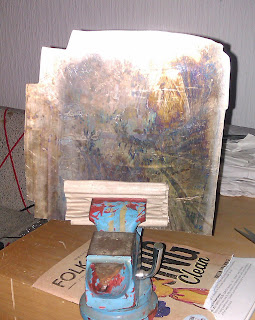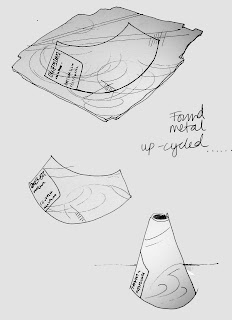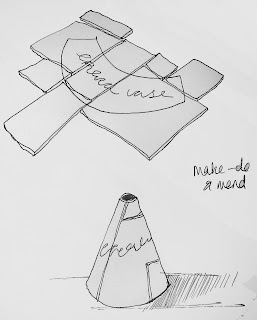Whilst filing the edges of some of my metal gallery pieces over Christmas, I started noticing the beauty of the backs of the pieces; the accidental, or incidental scratches and the unplanned oxidisation of the surface.
This got me thinking about a phrase that kept coming back to me on my visits to the museum; 'Make do and mend'. The tinsmith not only made new products for customers, but fixed old items too. When times were hard, nothing could be wasted; copper kettles with holes in were patched up; tin cans, mended.
With this ethos in mind, I thought about using found metal, from around my studio, and perhaps elsewhere if I can find it, to make my commission for the Tinsmith workshop. If pieces aren't big enough, I can solder sheets together in a patchwork. As well as perpetuating the make-do and mend ethos, the seams created by soldering metal sheets together, provide an interesting surface texture, and tell the story of the origin of the object's material. Scratches and oxidisation on the metal's surface echoes the aged and worn objects in the museum collection.
Here's the back of my gallery-piece, which triggered off my ideas....
A sketch showing the use of a discarded piece of metal, acid-etched with the surface pattern of a template from the Tinsmith workshop, and cut out to be formed in to a cone-shape.
A sketch showing how metal sheets could be soldered together, then acid-etched and cut out to be formed in to a cone-shape.
This Blog follows Artist Rebecca Gouldson as she creates a commission for, and inspired by, the Dales Countryside Museum. Rebecca has worked with the museum collection of objects and tools relating to local Dales Crafts, and has used them as a starting point for the collections of metalwork she will create and install at the museum. This project was commissioned by Chrysalis Arts on behalf of North Yorkshire Open Studios
Thursday 29 December 2011
Monday 19 December 2011
Visit to Investigate the collection in more detail
Inspired by the cardboard and metal templates in the tinsmith workshop, I requested a closer look. By separating these groups of templates, drawing around them to make my own templates, and photographing series of them, I collected visual information to start working with for my commission.
Pencil marks drawn around the templates.
Marks made in a lead hammering block in the Tinsmith workshop.
The face of a wooden mallet.
The top of a stake - used to shape metal.
Groups of templates.
Groups of handles
A copper kettle under construction.
First visit to the museum November 2011
On a chilly day in November I set off up the M6 to visit the Dales Countryside Museum for the first time. I had planned to focus my investigations on particular areas of the collection, including agricultural and craft tools, but I also wanted to be open to finding things that would inspire me on the day. Here are a few of the photographs I took on the day.
These shoe lasts were used to make leather shoes in the local area.
Rows of tools in the Tinsmith workshop. I was perhaps most drawn to the tinsmith workshop area in the museum, because of the similarities with my own metalworking practice.
Odd drawer handles used; 'Make-do and mend'.
These cardboard and metal templates, used by the Tinsmith to cut out the separate parts of flat tin sheet to be shaped and joined, were particularly inspiring.
The Tinsmith workshop
As a hobbyist hand-knitter myself, the collection of objects originating from the old hand-knitters of the Dales, from the were particularly interesting. Stacked here are sock stretching molds, used to stretch hand-knitted socks to the correct size. Each wooden mold is stamped with their size.
These butter moulds, stamps and rollers, were used to decorate and identify local dairies' produce. These appealed to my love of mark-making tools and moulds.
These shoe lasts were used to make leather shoes in the local area.
Rows of tools in the Tinsmith workshop. I was perhaps most drawn to the tinsmith workshop area in the museum, because of the similarities with my own metalworking practice.
Odd drawer handles used; 'Make-do and mend'.
These cardboard and metal templates, used by the Tinsmith to cut out the separate parts of flat tin sheet to be shaped and joined, were particularly inspiring.
The Tinsmith workshop
As a hobbyist hand-knitter myself, the collection of objects originating from the old hand-knitters of the Dales, from the were particularly interesting. Stacked here are sock stretching molds, used to stretch hand-knitted socks to the correct size. Each wooden mold is stamped with their size.
These butter moulds, stamps and rollers, were used to decorate and identify local dairies' produce. These appealed to my love of mark-making tools and moulds.
Subscribe to:
Posts (Atom)

























